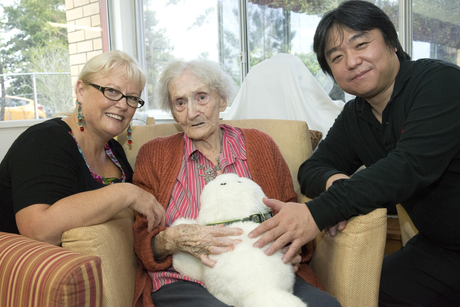Robots play role in dementia treatment

Previous work by Professor Wendy Moyle and her team at the Griffith Health Institute on the Gold Coast found that contact with a robotic seal named ‘Paro’ created many positive benefits for elderly people with dementia, including lowering anxiety and improvements in mood.
Developed by Japanese engineers and already used in several countries, the Paro - which costs around $5000 - responds to touch, light, voice and temperature. It also has posture sensors, via which it can perceive people and its environment.
Moyle is now planning to conduct a large-scale study involving about 400 participants from 30 nursing homes to quantitatively evaluate the robot’s benefits.
The Paro has some fantastic benefits for the treatment of dementia patients but so far we do not have a large-scale quantitative evaluation that examines the effect of the Paro on an individual’s emotional state and its cost-benefit in reducing pharmacological costs. This is what we will be trying to achieve in this study, if we are successful in achieving funding,” said Moyle.
“With an extended research team, we will be assessing emotional states in participants such as agitation, using measures including video observation and assessment of physiological responses.”
The evidence the researchers collect will be used to compare the cost-effectiveness of the Paro within care facilities with the costs of pharmaceutical treatment for people with dementia.
“If, for example, we are able to show that we can reduce psychotropic medication to a patient by 10% by using the Paro or alternatively show that they can stay at home for longer without admission to a care facility, then that would be a fantastic result with direct cost benefits.”
Professor Takanori Shibata, one of the Japanese research scientists behind the Paro, said that he is confident the robot will prove its worth to the Australian market.
“The Paro is gradually gaining more acceptance as a treatment for dementia around the world. In 2009, it was certified by the Federal Drug Administration in the US as a medical device and we are hopeful of similar success to come in Australia,” Shibata said.
Mini lung organoids could help test new treatments
Scientists have developed a simple method for automated the manufacturing of lung organoids...
Clogged 'drains' in the brain an early sign of Alzheimer’s
'Drains' in the brain, responsible for clearing toxic waste in the organ, tend to get...
World's oldest known RNA extracted from woolly mammoth
The RNA sequences are understood to be the oldest ever recovered, coming from mammoth tissue...





